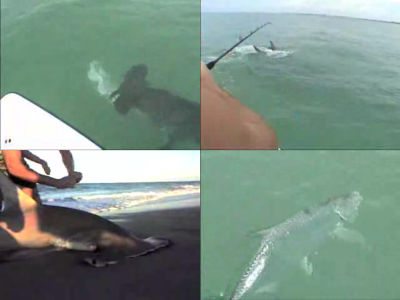A new way to avoid being attacked by aggressive sharks in the ocean has been discovered

About 80 shark attacks are reported around the world every year, some of which result in fatal injuries. As beaches around the world are taking measures to protect against sharks, a research team from Macquarie University in Australia has announced a way to protect people from sharks using LED lights.
Counterillumination reduces bites by Great White sharks: Current Biology
Scientists reveal how to avoid a shark attack - and their method is surprisingly simple | Daily Mail Online
https://www.dailymail.co.uk/sciencetech/article-14076885/How-avoid-shark-attack-science.html
Counterillumination reduces bites by White sharks / Curr. Biol., Nov. 11, 2024 (Vol. 34, Issue 24) - YouTube
The waters around Australia are home to many carnivorous and aggressive great white sharks. According to the research team, great white sharks are apex predators at the top of the food chain, but they have very poor eyesight and are not good at distinguishing colors, but they are good at finding objects at a distance. In other words, sharks decide whether to attack or not by looking only at the silhouette of their prey.

In many cases, people who enjoy surfing in the ocean are attacked by great white sharks because the great white shark mistakes a surfboard floating on the surface of the ocean for a seal. Therefore, the research team thought that it would be possible to reduce the number of human attacks by preventing great white sharks from noticing surfboards.
The team conducted an experiment in South African waters where great white sharks are common, towing a polystyrene model of a seal by boat, which was equipped with various lighting patterns using LEDs.

As a result, it was revealed that the model without LED lighting was immediately attacked or chased by the great white shark, while the model with LED lighting was attacked by the great white shark much less frequently. According to the research team, the brightness of the LED lighting is particularly important, and the model with the maximum brightness setting was hardly attacked by the great white shark. In other words, the LED lighting played a role like camouflage.

Furthermore, the frequency of attacks also changed depending on the LED lighting pattern. In particular, it was found that attacks were less frequent when the LED lights were arranged in horizontal stripes than when they were arranged in vertical stripes. The research team speculates that arranging the LED lights in vertical stripes makes the slender silhouette easier to see, making it easier for great white sharks to recognize them.

In addition, when a normal model was floated and a 'constantly lit LED light' and a 'flashing LED light' were thrown into the sea, it was found that the model was attacked more frequently when the flashing LED light was thrown in compared to the constantly lit LED light. From this, the research team argues that the great white shark is not simply afraid of the light, but is determining the silhouette of the model from the brightness and darkness of the light.
The research team said further testing is needed to see if the technique has the same effect on great whites and other sharks, but they hope that their discovery could help protect both surfers and sharks.
The research team also considered using a surfboard-shaped model for the experiment, but South African authorities did not allow it, pointing out the possibility of danger to local surfers.
Related Posts:







